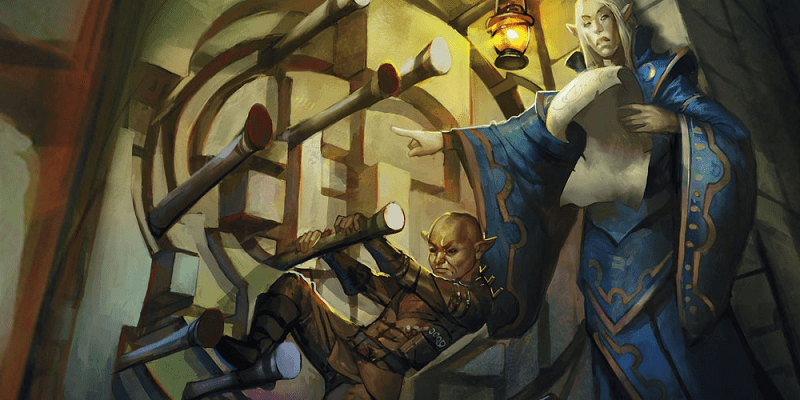WotC Sage Advice – Rules Answers: March 2016

There is a new Sage Advice article on the Wizards of the Coast D&D website by Jeremy Crawford. The focus of this month’s Sage Advice is on rules answers about druids wearing metal armor, bonus actions and spellcasting, and some answers concerning dispel magic and mage armor.
Below is a summary of the article for your convenience or you can visit D&D’s website to read the full article.
What happens if a druid wears metal armor?
- Druids have a taboo against wearing metal armor and wielding a metal shield that has been part of the class’ history since the class first appeared in 1976. The idea is that druids prefer to be protected by animal skins, wood, and other natural materials that aren’t the worked metal that is associated with civilization. Druids don’t lack the ability to wear metal armor. They choose not to wear it. This choice is part of their identity as a mystical order. Think of it in these terms: a vegetarian can eat meat, but the vegetarian chooses not to.
- A druid typically wears leather, studded leather, or hide armor, and if a druid comes across scale mail made of a material other than metal, the druid might wear it.
- As long as you abide by your character’s proficiencies, you’re not going to break anything in the game system, but you might undermine the story and the world being created in your campaign.
Does the rule on casting a bonus action spell apply when you take a bonus action granted by a spell?
- The rule on casting a spell as a bonus action (see PHB, 202) applies only on the turn you cast the spell. For example, spiritual weapon can be cast as a bonus action, and it lasts for 1 minute.
- On the turn you cast it, you can’t cast another spell before or after it, unless that spell is a cantrip with a casting time of 1 action.
- Until spiritual weapon ends, it gives you the option of controlling its spectral weapon as a bonus action.
- That bonus action does not involve casting a spell, despite the fact that it’s granted by a spell, so you can control the weapon and cast whatever spell you like on the same turn.
Can you use dispel magic to dispel a magical effect like a vampire’s Charm ability?
- Dispel magic has a particular purpose: to break other spells. It has no effect on a vampire’s Charm ability or any other magical effect that isn’t a spell. It also does nothing to the properties of a magic item. It can, however, end a spell cast from a magic item or from another source. Spells—they’re what dispel magic is about. For example, if you cast dispel magic on a staff of power, the spell fails to disrupt the staff’s magical properties, but if the staff’s wielder casts hold monster from the staff, dispel magic can end that spell if cast on the target of hold monster.
- There are abilities and other spells that can end or suspend magical effects that aren’t spells. For example, the greater restoration spell can end a charm effect of any sort on a target (such as a vampire’s Charm or a dryad’s Fey Charm), and a paladin’s Aura of Devotion can prevent or suspend such an effect.
- Three of the most versatile spells for ending certain magical effects are lesser restoration, greater restoration, and remove curse.
Can you use dispel magic on the creations of a spell like animate dead or affect those creations with antimagic field?
- Whenever you wonder whether a spell’s effects can be dispelled or suspended, you need to answer one question: is the spell’s duration instantaneous?
- If the answer is YES, there is nothing to dispel or suspend. Here’s why: the effects of an instantaneous spell are brought into being by magic, but the effects aren’t sustained by magic (see PHB, 203). The magic flares for a split second and then vanishes. Examples:
- instantaneous spell animate dead harnesses magical energy to turn a corpse or a pile of bones into an undead creature. That necromantic magic is present for an instant and is then gone. The resulting undead now exists without the magic’s help. Casting dispel magic on the creature can’t end its mockery of life, and the undead can wander into an antimagic field with no adverse effect.
- cure wounds instantaneously restores hit points to a creature. Because the spell’s duration is instantaneous, the restoration can’t be later dispelled. And you don’t suddenly lose hit points if you step into an antimagic field!
- If the answer is NO, a spell like conjure woodland beings has a non-instantaneous duration, which means its creations can be ended by dispel magic and they temporarily disappear within an antimagic field.
Can you ready dispel magic to stop another spell from taking effect?
- The easiest way to stop a spell is to cast counterspell on its caster while it’s being cast. If successful, counterspell interrupts the other spell’s casting, and that spell fails to take effect. Counterspell works against any spell, regardless of a spell’s casting time or duration.
- With the Ready action, dispel magic can be cast in response to another spell being cast, yet dispel magic can’t substitute for counterspell. The main reason is that dispel magic removes a spell that is already on a target, whether that target is a creature, an object, or some other phenomenon. Dispel magic can’t pre-dispel something. If a spell isn’t already present on a target, dispel magic does nothing to that target. The best that a readied dispel magic can do is dispel a spell immediately after it’s been cast to prevent it from having any effect after the action used to cast it. For example, on your turn you could say something like this: “I ready dispel magic, and if the high priest casts a spell on anyone, I cast dispel magic on the target if the spell takes hold.” If the high priest then cast hold person on your companion who fails the save against it, you could unleash your readied dispel magic and end hold person.
Can you use a shield with mage armor?
- Mage armor works with a shield. Shields are grouped with armor in the equipment rules in the Player’s Handbook, but various game features distinguish between the armor you wear and a shield you wield. Take a look at the monk’s Unarmored Defense feature and compare it to the barbarian’s version to see what I mean. In the monk’s version, you must both forgo wearing armor and forgo wielding a shield if you want to benefit from the feature, whereas a barbarian must only forgo wearing armor.



